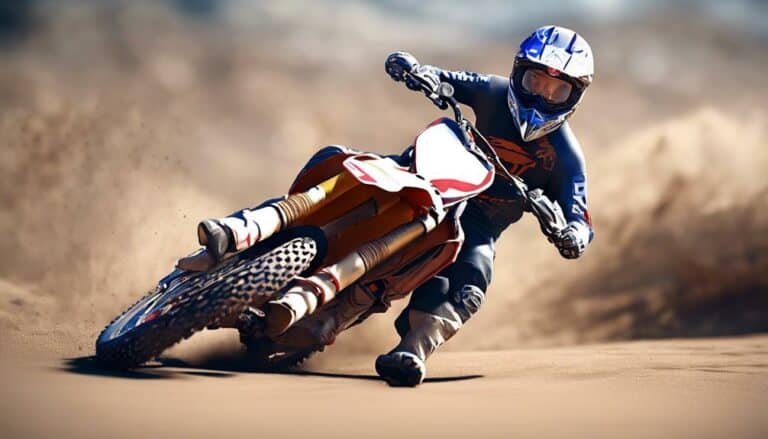As you lean into a sharp turn on your dirt bike, mastering the art of adjusting your speed and line becomes important for a smooth ride.
Understanding how to effectively apply braking techniques, maintain visual focus, and position your body can make all the difference in tackling challenging terrain.
By honing these skills, you'll not only enhance your control and precision but also boost your confidence on the trail.
So, how exactly can you fine-tune your approach to conquer those twists and turns with finesse?
Key Takeaways
- Proper speed adjustment is crucial for control and precision in dirt bike turns.
- Modulate throttle and brakes to match the chosen line for optimal traction.
- Body positioning and counterbalancing enhance stability and maneuverability.
- Effective braking techniques are essential for speed control and maintaining stability in turns.
Importance of Proper Speed Adjustment
Proper speed adjustment on a dirt bike is fundamental for maintaining control and executing precise maneuvers through turns. When approaching a turn, your speed directly impacts your ability to control the bike, adjust your body position, and lean into the curve effectively.
By slowing down appropriately before the turn, you enhance your stability and traction, allowing you to follow the desired line through the corner. This adjustment not only sets you up for a smoother entry but also positions you optimally for a successful exit. Anticipating the turn's sharpness and adjusting your speed accordingly is key to navigating it smoothly while maximizing control.
Furthermore, the correct speed adjustment enables you to choose the best line, ensuring that you have the necessary stability and traction to maneuver through the turn with confidence. Mastering speed adjustment is crucial for riders seeking to enhance their overall riding experience and prowess on the dirt track.
Techniques for Adjusting Riding Line
When approaching a turn, your ability to adjust your riding line effectively can greatly impact your traction and control on the dirt bike. To optimize your line choice, assess the turn radius early on and select a path that offers the best traction and control. Adjust your speed by smoothly modulating the throttle and applying brakes as needed to match the chosen line.
Proper body positioning is essential; lean the bike into the turn while keeping your body balanced to maintain stability throughout the maneuver. Anticipate any obstacles or changes in terrain by looking ahead, allowing you to make proactive speed and line adjustments.
Body Positioning for Turn Optimization
Optimizing your body positioning plays an essential role in enhancing balance and control while maneuvering turns on a dirt bike. Proper technique can make a significant difference in your cornering abilities. Here are three key strategies for optimizing your body positioning:
- Counterbalancing: Leaning your body in the opposite direction of the turn helps maintain balance and control, preventing the bike from tipping over.
- Open Hips and Chest: By opening your hips and chest towards the direction of the turn, you improve stability and enhance your ability to navigate corners effectively.
- Pressing Knee Against Tank: Pressing your knee against the outside of the tank aids in counterbalancing the bike, ensuring proper weight distribution and control throughout the turn.
Mastering these body positioning techniques won't only enhance your stability and control but also boost your overall maneuverability, allowing you to tackle corners with confidence and precision.
Utilizing Braking Techniques Effectively
Mastering effective braking techniques is essential for maintaining control and adjusting speed while maneuvering turns on a dirt bike. When approaching a turn, utilizing both front and rear brakes allows for gradual speed reduction, enhancing stability. Applying firm yet controlled pressure on the brakes is key to adjusting speed while ensuring stability and control. Additionally, integrating engine braking can aid in speed adjustment, particularly in challenging terrains. Understanding the traction limits of your dirt bike tires is critical for modulating braking force effectively and managing speed optimally. It's essential to adapt your braking technique according to surface conditions and the type of turn to maximize control and minimize the risk of skidding.
| Braking Techniques | Effective Speed Adjustment |
|---|---|
| Front and rear brakes | Gradual reduction |
| Firm pressure | Stability and control |
| Engine braking | Assistance in speed adjustment |
| Traction limits | Modulating braking force |
| Surface conditions | Adaptation for control |
Practicing Turn Approaches for Mastery
To enhance your proficiency in dirt bike maneuvering, honing your skills in practicing turn approaches is paramount. Mastering proper technique is critical for smoothly handling turns on a dirt bike. Here are three essential tips to help you excel in this aspect:
- Body Positioning: Lean your body in the opposite direction of the turn to initiate the lean of the bike effectively. This adjustment helps you maintain balance and control while tackling sharp corners.
- Practice Downshifting: Downshift smoothly as you approach a turn to match the bike's speed with the curve's requirements. This practice guarantees a smooth alteration and prevents any jerky movements that can destabilize your ride.
- Utilize Front Brake: Skillfully utilize the front brake to control your speed while entering a turn. Applying the front brake in conjunction with proper body positioning helps in shifting the center of gravity, allowing for better control and stability throughout the turn.
Conclusion
To sum up, mastering the art of adjusting speed and line on a dirt bike during turns is like dancing with the wind.
By combining precise braking techniques, visual focus, and strategic body positioning, riders can glide through corners with finesse and control.
Practice and dedication are key to mastering this skill, ensuring a smooth and exhilarating ride every time.
So, keep honing your skills and embrace the thrill of conquering each turn with skill and precision.

